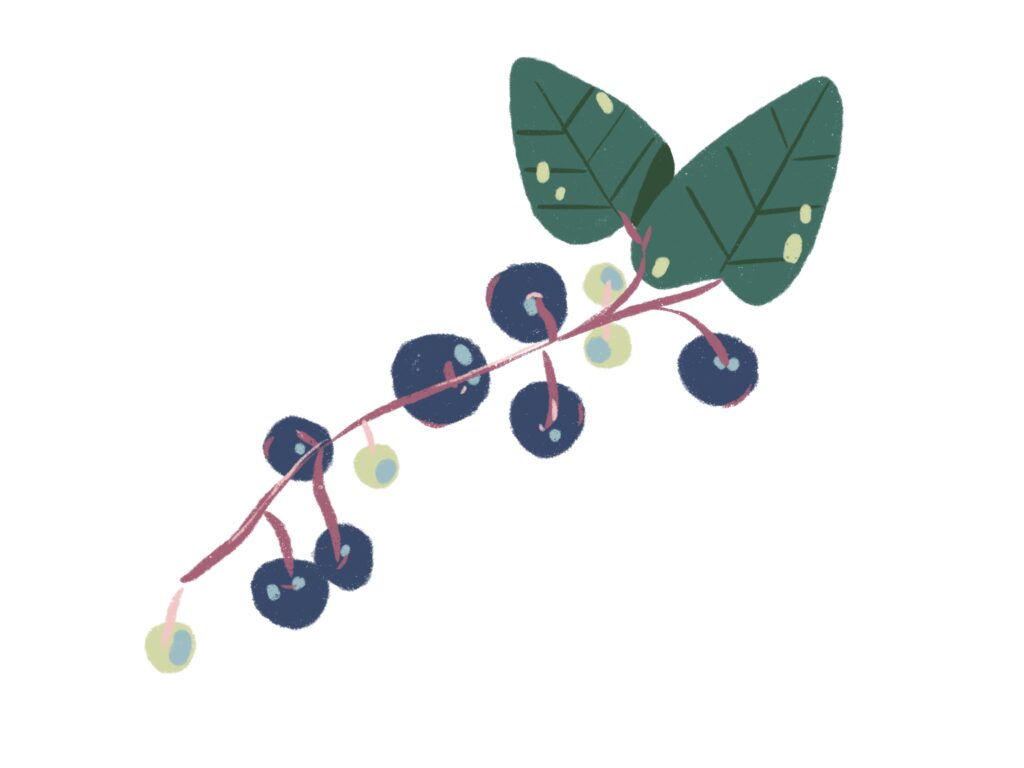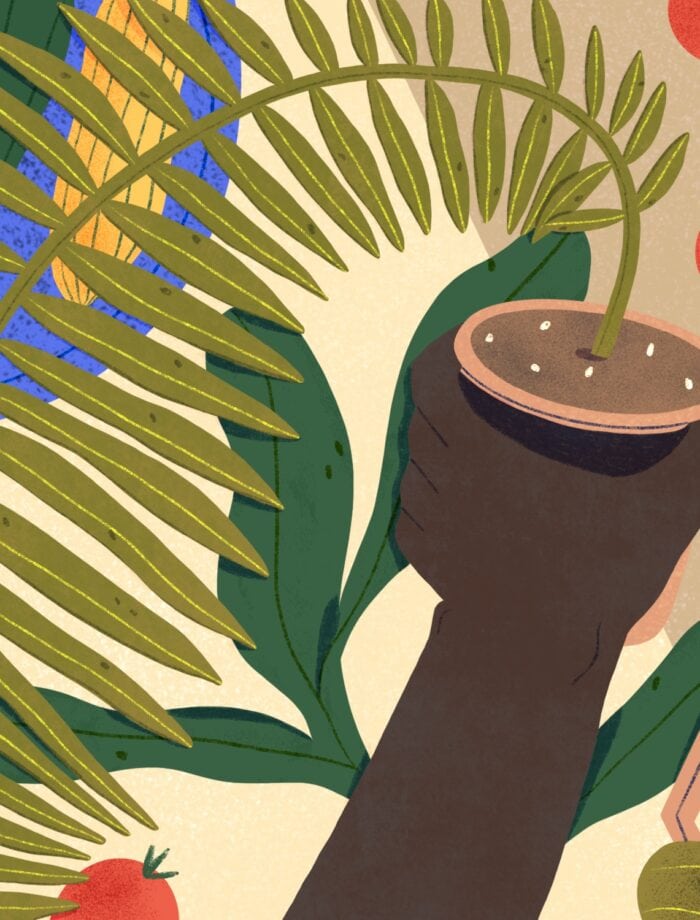This article was written on the lands of the Clackamas, Multnomah, Cowlitz, and other tribes who are now members of the Confederated Tribes of Grand Ronde, the Confederated Tribes of Siletz Indians, and the Chinook Indian Nation.
Tu Bishvat is this weekend. It’s a Jewish holiday that started out as an accounting date, establishing which trees were old enough to harvest from. Over the past few millennia, the holiday evolved into an opportunity to be grateful for trees and think about our surrounding environments.
I have strong feelings about Tu Bishvat — such strong feelings, in fact, that I’ve published two separate zines about just this one holiday. I’m publishing a new zine for the holiday this year. Last year’s zine, “Towards a New Tu Bishvat,” was a broad look at the future of the holiday. This year, I collaborated with Meli Sameh, to create new traditions for the holiday centered on our shared home in the Pacific Northwest in Guests on This Land: a PNW tu bishvat zine.
What is Tu Bishvat?
The concept of the Tu Bishvat celebration — observing the growth of trees in the last year, tasting the first fruits of the season, and holding a seder to learn more together — appeals to me. But some of the traditions and modern interpretations of the holiday don’t align with my interpretation of Judaism.
One particular tradition stands out. Because Tu Bishvat evolved in Eretz Yisrael (an area also known as the Land of Canaan, Palestine, Israel, the Holy Land, the Southern Levant, etc.), the Tu Bishvat seder centers around fruits grown in the region that would have been available this time of year. Jerusalem’s latitude is 31° 46′. I live at the latitude of 45° 31′. To get the type of fruits traditionally associated with Tu Bishvat, like dates, figs, and carob, I either need to wait an extra couple of months or ship them thousands of miles.
The carbon footprint alone for that fruit could require a tree a full year to absorb. It’s a redundant way to observe the “Birthday of Trees.” It makes observing holidays more expensive and less accessible, as well. Tu Bishvat isn’t the only Jewish holiday that requires importing ritual items from far away. Finding locally-made Shabbat candles — or even made fewer than 6,000 miles away — requires pouring over packaging and even digging into manufacturers online.
Some of these traditions are relatively new. Some are the result of the continuing commodification of the world under capitalism — local matzah bakers gave way to a handful of companies that manufacture and ship matzah in time for Pesach each year. Others, especially those focused on buying products manufactured in Israel, come from more complicated places. After the end of the Shoah and World War II, most branches of Judaism shifted into a sort of hyper-nationalistic Zionism, far beyond anything seen in Jewish culture before.
There’s a tradition of making new traditions within Judaism.
But the Diaspora is core to Judaism. Our traditions evolved during thousands of years of living in different places. There’s always been a tug towards Eretz Yisrael — shipping fruit from Eretz Yisrael for Tu Bishvat was common long before we had the option of finding fresh berries at the supermarket in the middle of the winter. But there’s also always been arguments about what sort of relationship with Eretz Yisrael is useful, appropriate, or even necessary.
Inspired foodways
All of this means that there’s a tradition of making new traditions within Judaism — of figuring out what works in the places we happen to be now. In my mind, that evolution is one of the most important parts of being Jewish. There are other advantages to building our relationships with the land through the lens of our spiritual practices.
I’m not Indigenous to this place and, while I value growing roots here, I’ll never be Indigenous. In Braiding Sweetgrass, Robin Wall Kimmerer discusses a sort of ‘naturalization’ that I think is a good description of what I hope to achieve:
“Being naturalized to place means to live as if this is the land that feeds you, as if these are the streams from which you drink, that build your body and fill your spirit. To become naturalized is to know that your ancestors lie in this ground. Here you will give your gifts and meet your responsibilities. To become naturalized is to live as if your children’s future matters, to take care of the land as if our lives and the lives of all our relatives depend on it. Because they do.”
Wall Kimmerer has also discussed her own ways of using ceremony to connect to the land, in a way that makes me value my own Jewishness in this context: “Ceremony is a vehicle for belonging — to a family, to a people, and to the land…Ceremony focuses attention so that attention becomes intention. If you stand together and profess a thing before your community, it holds you accountable.”
Local eats
Late last year, I discussed the idea of bringing all these concepts together with Meli. The result is Guests on This Land: a PNW tu bishvat zine, a zine where we discuss different fruits from the Pacific Northwest as part of celebrating Tu Bishvat. We specifically looked at
- camas, known as lakamas in Chinuk Wawa
- salal berries, known as salal-ulali in Chinuk Wawa
- redcedar, known as kʰalakwati-stik in Chinuk Wawa
- beaked hazelnuts, known as taqwəla in Chinuk Wawa
Please note that, in Tu Bishvat terms, ‘fruits’ are defined a little differently than in modern usage.
We researched each of these foods, both reading up on them and interviewing experts. Because these foods have different meanings in different tribes, we looked at tribes as far south as the Modoc and as far north as the Gitxsan.
One piece of this project that I want to emphasize is the necessity of respect and care when working around Indigenous traditions and symbolism. The research that went into it was painful — both because of the on-going efforts to destroy tribes and because Jews have taken part in the attempted genocide.
Perhaps one of the most revealing discussions I had was with a member of the Chinook tribe: while discussing Chinuk Wawa terms for camas, she shared that she’s never had the chance to eat camas, let alone camas prepared in a traditional fashion. When people with traditional ties to a food don’t have access to it, using my relative privilege to access that food is wrong and potentially harmful.
Consider quinoa, which became an international hit in the early 2000s. The grain has been grown in the Andean highlands, primarily in Bolivia and Peru, as a staple crop for thousands of years. International demand completely changed everything about how quinoa is grown in a matter of years: small family farms were replaced with conglomerates, more land was given over to agriculture, and production ramped up far beyond what consumption required. Quinoa is an important object lesson when it comes to exploring Indigenous foodways.
While I’m always ready to learn more, showing respect also means realizing that not all knowledge is for me. Redcedar is a good example: most of the tribes I’ve read up on prefer to not share information on certain medical uses for redcedar. The tree is central to certain ceremonies, even called “the Tree of Life” in multiple tribes. We must respect that boundary and, as much as possible, understand the necessity for that boundary.
When learning about Indigenous foodways, respecting boundaries is both necessary and good for our health.
We included redcedar in Guests on This Land, in part, because of its importance as a symbol. Jewish texts discuss our own “Tree of Life,” and celebrate other types of cedars. Redcedar offers an important point of connection and an opportunity to understand those boundaries aforementioned. Redcedar’s medical properties make those boundaries firmer — consuming redcedar improperly can affect one’s health, just like any other medication. That’s not a bad thing, but rather a factor to be aware of.
When learning about Indigenous foodways, respecting boundaries is both necessary and good for our health. And when we can learn about such foods, we need to respect and follow traditional preparation techniques. The alternative is giving yourself a stomach ache with improperly prepared camas, or even winding up with death camas rather than the edible kind.
Balancing those boundaries throughout Guests on This Land required a lot of thought: we want to honor and discuss these fruits, but we don’t want to compound the harm done to traditional foodways. Our compromise is offering alternatives that are easier to access. I expect we’ll continue to learn new ways to compromise, as well as to respect Indigenous stewardship of these lands — this zine is only a starting point.
This project has given me a lot of hope for the future. I have plans to keep looking at Jewish holidays and how I can root them where I live — making hamantaschen filled with salal berries and other local fruits is one of my goals for Purim. And I hope that people living in other parts of the world revisit their traditions as well — I’ll feel that this project truly succeeds when I see a Tu Bishvat seder on Anishinaabe land with maple candy or on Piipaash land with prickly pear.
Consider that your call to action: look at how you can tie your spiritual practices and food traditions and life more closely to where you live. Then share those ties back to your community (and maybe me if you have the time).
You can download Guests on This Land at Itch.io.

Salal berry syrup
Ingredients
- 1/4 cup water
- 1/4 cup honey, local if possible
- 2 cups fresh salal berries
To-do’s
1. Combine salal berries, water, and honey over medium-high heat. Bring mixture to a boil.
2. Reduce heat to a simmer and mash berries thoroughly.
3. Cover and simmer until mixture has thickened. This typically takes a few minutes.
4. Remove from the heat. Strain through cheesecloth. Serve warm or store in the refrigerator for later use.
For a thicker syrup, whisk in 1 teaspoon of cornstarch after mashing berries.
Note: Salal berries are not grown commercially. While local plant nurseries in the Pacific Northwest often carry salal plants, foraging is also an option for some. Salal berries grow wild on shrubs in both evergreen forests and sunny areas. Gather berries when they are plump and dark blue. If you choose to forage, please follow the principles of the Honorable Harvest. This recipe can also be prepared using other fresh berries.






